
Sarreguemines Pompadour Faience Dinner Set, 19th Century, Fifty Pieces
An extensive 'Pompadour' pattern faience dinner setting by Sarreguemines, French, 19th century, comprising dinner plates, entree plates, comports, bowls and a jug, approximately fifty pieces, the largest comport 13.5 cm high, 25 cm diameter

Sarreguemines Majolica Covered Dish, Fruit Lid, Basket Base, 1900
A French Sarreguemines Majolica covered dish, circa 1900 the fruit moulded and glazed lid with vegetal finial, over a basket form base with side handles, with impressed Sarreguemines France mark, numbers and other cyphers to the underside. Height 13.5 cm,…

French Majolica Asparagus Serving Tray by Sarreguemines, circa 1900
A French Majolica asparagus serving tray by Sarreguemines, circa 1900 the serving tray moulded as a cradle of twelve asparagus spears over a an oval platter with basket weave side handles and foliage in yellow, emerald, blue, brown, and touches of purple…
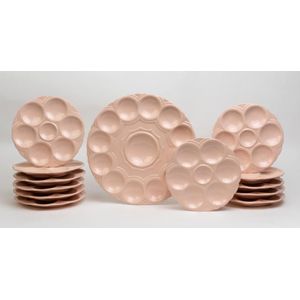
Pink Sarreguemines Oyster Plate Set with Platter
A set of pale pink porcelain oyster plates by Sarreguemines, France, comprising twelve plates and one platter, green underglazed factory mark to base, the platter 36 cm diameter

French Majolica Character Jugs with Advertising Interest
Two French Majolica character jugs, one with advertising interest, early 20th century, both by Sarreguemines, both pattern 3181, a large advertising 'Jolly Fellow' character jug, 'King o' Tonics Quinol' with retailer's mark of Cawsey, Menck & Co Melbourne…
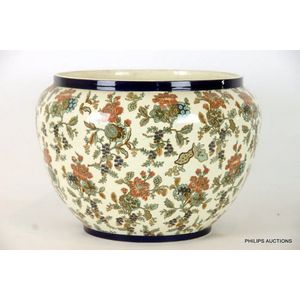
Sarreguemines Ceramic Jardiniere with Eastern Flower Design
A Sarreguemines ceramic jardiniere, 1920-1950s period, the large jardiniere decorated throughout with a transferware Eastern flower design in russet, teal and brown colours upon a cream ground, script mark of Sarreguemines underside, height 23.5 cm,…

Emerald Green Corn Cob Jug
A Sarreguemines Majolica jug, early 20th century, the large moulded jug in the form of the corn cob in bright emerald green and yellow colours and having a vegetal handle; impressed marks, backstamps underside with pattern numbers, height 19 cm

French Ceramic Footbaths, c. 1920
Digoin & Sarreguemines two French graduated ceramic Footbaths, c. 1920, white glaze, of oval shape with two handles, printed factory marks to undersides (2), approx. Height 21 cm length 42 cm. Provenance: The Collection of Mr and Mrs Matthew Handbury,…
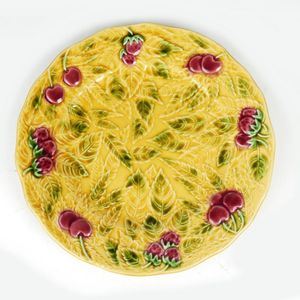
Cherry and Strawberry Majolica Plate, 25cm
A Sarreguemines majolica plate, patterned with cherries and strawberries, diameter 25 cm

Fruit-patterned Sarreguemines Majolica Tazza (23.5 cm diameter)
A Sarreguemines majolica low footed tazza, patterned with fruit, diameter 23.5 cm

Fruit-patterned Sarreguemines majolica platter, 29.5 cm
A Sarreguemines majolica circular platter, patterned with fruit, diameter 29.5 cm

Fruit Patterned Oval Platter from Sarreguemines - 31.5 cm
A Sarreguemines majolica oval platter, patterned with fruit. Width 31.5 cm

Cherry-patterned Sarreguemines majolica dish with cover
A Sarreguemines majolica dish and cover on fixed saucer, patterned with cherries, diameter 20 cm

Blueberry-patterned Sarreguemines Majolica Oval Dish (24cm)
A Sarreguemines majolica oval dish, patterned with blueberries. Width 24 cm

Strawberry Majolica Oval Dish with Handles
A Sarreguemines majolica oval two handled dish, patterned with strawberries. Width 35.5 cm

Fruit-patterned Sarreguemines majolica handled basket, 21 cm diameter
A Sarreguemines majolica handled basket, patterned with fruit, diameter 21 cm

Fruit-patterned majolica basket dish with cover
A Sarreguemines majolica basket dish and cover, patterned with fruit, diameter 17 cm
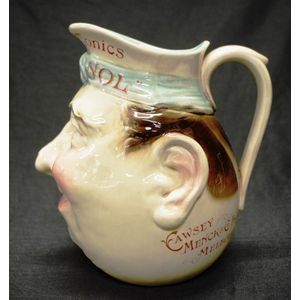
Sarreguemines 'Quinol' Character Jug, 22cm
Early Sarreguemines 'King of Tonics' character jug, titled 'Quinol,' and 'Cawsey Menck & Co Pty Ltd, Sole Australian Proprietors,' face jug, marked to base, height 22 cm

French Majolica Fruit Tureen with Lid and Basket Base
An old French Sarreguemines majolica lidded tureen, the fruit moulded and glazed lid on basket form base.

French Majolica Cheese Dish with Fruit Lid
An old French Sarreguemines majolica cheese dish and cover, the fruit moulded and glazed lid on leaf moulded base, diameter 21 cm
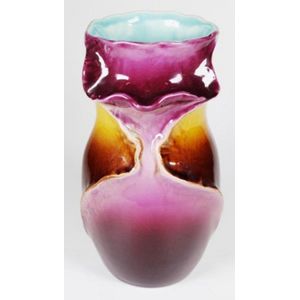
Burgundy and Brown Art Nouveau Ceramic Vase
Art Nouveau Sarreguemines France ceramic vase burgundy and brown glaze decoration to iris form, marked to base and # 3246, height 25 cm

Sarreguemines Commemorative Plates of Nicholas I and Alexandra
Pair of Sarreguemines commemorative plates, of circular form, depicting Nicholas I and Alexandra Fedeorowna, surrounded by Royal scenes, diameter 22 cm (2)

Sarreguemines Majolica Pig Pitcher, 20th Century
A French Majolica pig pitcher by Sarreguemines early 20th century, pattern 3318, a rather self-satisfied rotund pig in natural pink colours, glazed teal to the interior, impressed maker's mark and pattern underside, height 24 cm

Sarreguemines Asparagus Plate, 1900
A French Majolica asparagus plate by Sarreguemines, circa 1900, the moulded plate with arranged asparagus spears and transferware floral decoration, impressed marks underside, height 2.5 cm, diameter 26 cm

French Patriotic Plates with Famous Portraits and Scenes
A collection of French patriotic plates by Sarreguemines, most depicting a portrait of a famous Frenchman with scenes from his life; includes Czar Nicholas II and his wife, Alexandra. (11).

"Exhibition Visitors" Sarreguemines Side Plate Collection
Collection of side plates (12) by Sarreguemines; the series depicts different nationalities visiting the Exhibition.

Sarreguemines Exhibition Side Plate Collection
A collection of side plates (10) by Sarreguemines depicting various national types and scenes at the exhibition.

Sarreguemines Exposition Side Plate Set (8 Views)
Set of side plates by Sarreguemines, each depicting a different view at the Exposition. (8).

French Military Plates from Sarreguemines (Set of 8)
Antique French Sarreguemines plates, mainly military related, each 20 cm diameter (8)

Cobalt Blue French Jardiniere on Gilt Stand - 162cm
Large French Sarreguemines jardiniere on stand, cobalt blue & gilt decorated, 162 cm high with stand

French Souvenir Plaques: Copper & Porcelain Pair (2)
Pair of pressed copper and Sarreguemines porcelain French souvenir plaques, each 30 cm diameter (2)

Fruit Majolica Square Bowl - 23 cm
French Sarreguemines majolica square bowl, with fruit decoration, 23 cm x 23 cm

French Sarreguemines Vintage Plates and Bowl Set
Vintage French Sarreguemines plates, bowl & strawberry bowl, 31 cm diameter & smaller

Assorted Majolica Leaf Plates and Dishes Set
Eight assorted Majolica plates/dishes, to include 4 leaf dishes, 3 leaf plates, and a French Sarreguemines leaf plate (as inspected)

French Sarreguemines Plates: 14 Drinking Scenes
Fourteen French Sarreguemines plates, of different drinking scenes, approx 21 cm dia (14)

French Strawberry Majolica Tureens
A pair of old French Sarreguemines majolica lidded tureens, moulded and glazed strawberry lids, basket weave bases. Diameter 17 cm

French Strawberry Majolica Tureen with Lid
An old French Sarreguemines majolica lidded tureen, the lid moulded and glazed as strawberries, similar to above.

French Majolica Fruit Tureen with Lid and Basket Base
An old French Sarreguemines majolica lidded tureen, the fruit moulded and glazed lid on basket form base, small chip to interior rim.

French Sarreguemines Lettuce Plate - Excellent Condition
A French Sarreguemines Lettuce form plate, in excellent condition, very minimal chipping to underside of plate's edge, length 21.5 cm

Sarreguemines Majolica Character Jug, 20 cm
Sarreguemines Majolica character jug marked to base, 20 cm high

French Military Humorous Plates & Plateau Set
Rare set of French Sarreguemines Military humorous plates & plateau plate, plates each 22 cm diameter (17)

Antique French Sarreguemines jugs with covers
Two antique French Sarreguemines jugs with covers, 21 cm high (tallest) approx
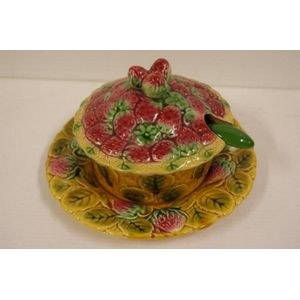
Sarreguemines Strawberry Jam Pot Set
French Majolica Sarreguemines jam pot, with under plate & spoon, strawberry decoration, 11 cm high approx.

Fruit-decorated Sarreguemines jam pot, 12cm wide
French Majolica Sarreguemines jam pot, with fruit decorated lid, 12 cm wide approx

Sarreguemines Oranges Platter - 29.5cm
French Majolica Sarreguemines 'oranges' platter, D29.5 cm approx

Sarreguemines Jolly Fellow Character Jug
Sarreguemines Majolica Jolly Fellow character jug with impressed marks to the base. Condition, good, expected age related crazing, height, 19.5 cm

Sarreguemines Cherry Tureen with Lid (9 words)
French Majolica Sarreguemines cherry lidded tureen diameter 21 cm approx

Fruit Majolica Charger and Comport Set
French Majolica Sarreguemines charger and comport both with fruit decoration, diameter 29.5 cm approx (charger)

Sarreguemines Majolica Fruit Tureen with Lid (9 words)
French Majolica Sarreguemines fruit lidded tureen D18 cm approx

French Majolica Fruit Tureens with Under Plates
Two French Majolica Sarreguemines lidded tureens and under plates, with fruit lids, D13 cm approx

Fruit Decorated Sarreguemines Majolica Tureen Set
Sarreguemines Majolica set of three fruit decorated tureens of various sizes, comprising a lidded berry dish & underplate, a lidded strawberry dish & a lidded cherry dish.

Wicker Fern Majolica Serving Tray
Sarreguemines Majolica serving tray having a wicker form bowl decorated with two fern leaves, woven edging with two ribbon form handles, stamped to the base.

John Barleycorn & John Bull Majolica Character Jugs
Sarreguemines Majolica John Barleycorn & John bull character jugs with John bull John known as 'Grotesque 3257' modelled with rosey cheeks, muttonchops & an upturned hungry collar, Barleycorn known as 'Grotesque 3181' modelled with rosey cheeks & wearing…

Corn-decorated Majolica Tureen with Lid by Sarreguemines
Sarreguemines Majolica early Corn decorated lidded tureen stamped to the base.

Fruit & Berry Majolica Dessert Set
Sarreguemines Majolica dessert suite comprising a serving dish & six side plates all decorated with various fruits & berries.

Darwin Monkey Candlestick with Top Hat
Sarreguemines Majolica Darwin monkey candlestick posed wearing a top hat in a seated position on a 'Darwin' book, stamped to the base.

Green Faience Scallop Plates Set, 19th Century
A set of nine green faience sarreguemines scallop plates, 19th century, the larger serving platter 37 cm diameter

Green Fish Dinner Set - Sarreguemines Faience, 1950s
A Sarreguemines green faience fish form dinner service- comprising nineteen plates, a jug and a platter, French, circa 1950

French Antique and Character Plates Set
Two antique French Sarreguemines plates and set of four French 'Le Langage des Fleurs' character plates.

Antique French Majolica Planters, Renaissance Revival
A pair of antique French Sarreguemines Renaissance revival majolica planters, approx 20 cm x 20 cm x 20 cm

Sarreguemines Majolica Pear Fruit Bowl (9 words)
French Sarreguemines majolica fruit bowl with pear decoration, 19 cm wide approx

Fruit-themed Majolica Tureen from Sarreguemines
French Sarreguemines majolica tureen with fruit decorations, as inspected

Set of 12 French Sarreguemines Plates by H. Gray
Twelve French Sarreguemines plates, by H. Gray 'Avant LE Depart, En Eqipe, Au Village, Loin De Paris, La Rue, a L'Entrainement', each approx 19 cm dia (12)

Sarreguemines Majolica Pear Fruit Bowl (38cm)
French Sarreguemines majolica fruit bowl with pear decoration, 38 cm wide approx.

Mid-century Sarreguemines Amazonas Dinner Service Set
A vintage part French dinner service by Sarreguemines, circa mid 20th century, in Amazonas pattern, the thirty piece creamware setting with handpainted sprigs centrally and to the rims comprising fourteen dinner plates, six soup bowls, five side plates, a…

Pair of Sarreguemines Majolica Pig Jugs
Sarreguemines Majolica pair of pig jugs with two holes in the snout, with impressed stamp 'Sarreguemines 3318 227 C5 12' condition good, some crazing & staining. Height 24.5 cm

Sarreguemines Majolica Character Jug "Qinol King" - Melbourne Proprietors
French Sarreguemines majolica character jug 'Qinol King of Tonics', made for Sole Australian Proprietors, Cawsey Menck & Co, Pty Ltd, Melbourne, 22 cm high approx., chip to rim

Sarreguemines Majolica Service Set
French Majolica Sarreguemines service to include plates, bowl, pot etc

French Sarreguemines Plates by H. Gray (Set of 12)
Twelve French Sarreguemines plates, by H. Gray 'Avant LE Depart, En Eqipe, Au Village, Loin De Paris, La Rue, A L'Entrainement' each approx 19 cm diameter (12)

French Majolica Oyster Plate, 37.5 cm Wide
Large French Sarreguemines majolica oyster plate, 37.5 cm wide

Sarreguemines Majolica Tureen and Oyster Tray Set
French Sarreguemines majolica tureen & oyster tray,

Set of 12 French Sarreguemines Plates by H. Gray
Twelve French Sarreguemines plates, by H. Gray 'Avant LE Depart, En Eqipe, Au Village, Loin De Paris, La Rue, a L'Entrainement' each approx 19 cm dia (12)

Fruit Relief Tureen from Sarreguemines, France
Sarreguemines France tureen with fruit in relief to lid, 24 cm diameter approx

Cherry Relief Tureen from Sarreguemines, France
Sarreguemines France tureen with red cherries in relief to lid, 24 cm diameter approx

Sarreguemines and Cerenord: Exquisite Tableware Services
French Sarreguemines and Cerenord St Amand part services

French Majolica Fruit Basket Pots
Two antique French Sarreguemines majolica pots, in the form of woven baskets with fruit bunch lids, 13 cm & 18 cm wide approx, the larger with hairline crack to lid

Sarreguemines Joan of Arc Antique Plates (Set of 11)
French Sarreguemines antique plates, Joan of Arc, of puce transfer surround and black transfer to centre (11)
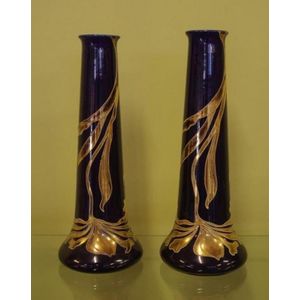
French Art Nouveau Vases, Sarreguemines, 31.5 cm
Pair of French Sarreguemines Art Nouveau vases, 31.5 cm high, as inspected

Sarreguemines Majolica Oyster Plates (Set of 6)
Set of six Sarreguemines Majolica Oyster plates, approx 24 cm diameter (6)

Set of 3 French Majolica Plates from Sarreguemines
Three French Sarreguemines majolica plates, approx. 20 cm diameter(3)

Antique Sarreguemines Majolica Square Planters (Pair)
Pair of antique Sarreguemines Majolica square form planters impressed (512), approx 20 cm high (2)

Majolica Fruit Dessert Set - Sarreguemines (7 pieces)
French Sarreguemines seven piece majolica fruit decorated dessert service (7)

French Event Plates by Sarreguemines (21cm)
Set of French Sarreguemines coloured plates decorated with important French events, approx 21 cm diameter

Green Majolica Oyster Plates Set (10)
Set of ten French Sarreguemines majolica green oyster plates (10)
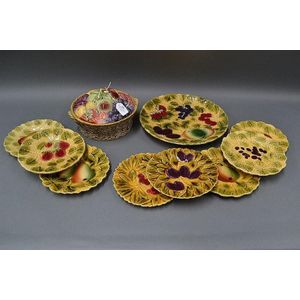
Sarreguemines Majolica Fruit Dessert Set with Tureen (10pc)
Sarreguemines Majolica ten piece dessert service, comprising of eight fruit decorated plates, large platter and a large mixed fruit decorated covered tureen (10)

Fruit Plates and Cherry Tureen Set
Sarreguemines Majolica five piece dessert service, comprising four fruit decorated plates and a cherry decorated covered tureen (5)

Restored Sarreguemines Face Jug, 21 cm Height
Sarreguemines face jug. (old staple restoration to rim). Height 21 cm

Majolica Fruit Dessert Set with Tureen (8 pieces)
Sarreguemines majolica fruit decorated dessert service,comprising 6 side plates, 1 large serving platter and a strawberry decorated covered tureen. (8 pieces )

Sarreguemines Ceramic Panther Figure - Vintage Prowling Statue
Vintage Sarreguemines white ceramic figure of a panther prowling. 23 cm high. 40 cm long







 Loading more...
Loading more...